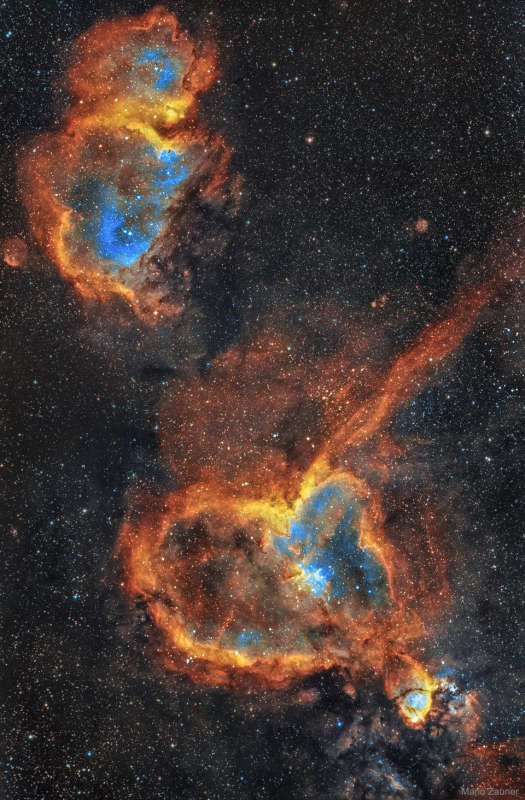Credit & Copyright: Mario Zauner
Explanation:
Is the heart and soul of our Galaxy located in
Cassiopeia?
Possibly not, but that is where two bright
emission nebulas nicknamed
Heart and Soul
can be found.
The Heart Nebula, officially dubbed
IC 1805 and visible in the featured
image on the bottom right, has a shape reminiscent of a classical
heart symbol.
The
Soul Nebula
is officially designated IC 1871 and is visible on the upper left.
Both nebulas shine brightly in the red light of
energized
hydrogen.
Also shown in this three-color montage is light emitted from
sulfur, shown in yellow, and
oxygen, shown in blue.
Several young open clusters of stars are visible near the nebula centers.
Light takes about 6,000 years to reach us from
these nebulas,
which together span roughly 300
light years.
Studies of stars and clusters like those found in the
Heart and
Soul Nebulas
have focused on how massive stars
form and how they
affect their environment.
Follow APOD on:
Instagram,
Facebook,
Reddit, or
Twitter
1999 2000 2001 2002 2003 2004 2005 2006 2007 2008 2009 2010 2011 2012 2013 2014 2015 2016 2017 2018 2019 2020 2021 2022 2023 2024 2025 |
Yanvar' Fevral' Mart Aprel' Mai Iyun' Iyul' Avgust Sentyabr' Oktyabr' Noyabr' Dekabr' |
NASA Web Site Statements, Warnings, and Disclaimers
NASA Official: Jay Norris. Specific rights apply.
A service of: LHEA at NASA / GSFC
& Michigan Tech. U.
|
Publikacii s klyuchevymi slovami:
Heart Nebula - emissionnaya tumannost' - Kassiopeya
Publikacii so slovami: Heart Nebula - emissionnaya tumannost' - Kassiopeya | |
Sm. takzhe:
Vse publikacii na tu zhe temu >> | |
